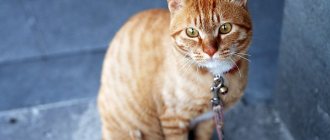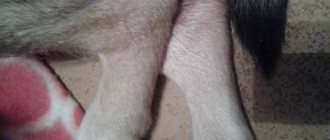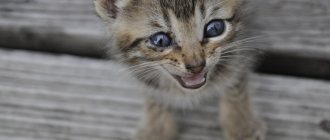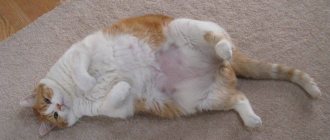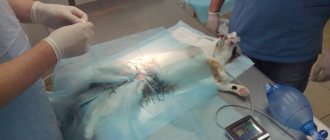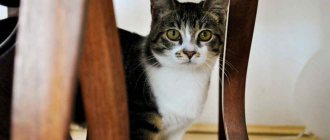What it is? Hereditary and breed predisposition
In general, the course of this disease is equivalent to the same processes that occur in the case of a person. Blood flow to the heart is greatly impaired, and the vital organ does not receive the proper amount of oxygen and nutrients. Entire sections of the heart muscle die, which subsequently leads to dire consequences. Roughly speaking, a sharp exacerbation of this process is an attack. What are the reasons for such a dangerous phenomenon?
Some kittens are born with a congenital heart defect or have a higher risk of heart attacks. Let us warn you once again that problems with the cardiovascular system are not very common for these animals, but they still happen. Veterinarians believe that no more than 1-2% of all kittens are born with congenital heart defects.
Hypertrophic cardiomyopathy, or HCM, is the most common type of heart disease in the entire feline family. In this case, the left ventricle of the heart initially undergoes severe hypertrophy, due to which the pressure in the atria increases sharply. This leads not only to accelerated wear and tear of the entire cardiovascular system, but also to an increased risk of developing both a heart attack and pulmonary edema.
Some breeds are more susceptible to developing this disease. Maine Coons, Ragdolls, and British cats are at increased risk. It should be noted that this pathology is not inherited in all cases. In any case, it's not that important. Almost any pathology that negatively affects the condition of the heart and blood vessels can lead to a heart attack. So it is much more important for the owner to know the first signs of this condition in order to urgently, without wasting time and without panicking, seek help from a veterinary specialist.
Features of heart failure in cats
For some reason, a pet’s heart may sometimes not perform all its functions.
This leads to a “failure” of the functioning of the entire organism as a whole. And if heart problems are not noticed in time, heart failure will develop. But everything starts small, gradually “gaining strength.” This disease in cats, the symptoms of which are unfamiliar to many, is associated with a complex of disorders. The incorrect rhythm in which the heart muscle contracts during this pathology disrupts blood circulation throughout the body. Uncontrolled attacks “eat up” all the energy, which can barely cope with the supply of oxygen and necessary nutrients to tissues and organs.
Symptoms
Cats, by nature, don't like to show weakness. Sometimes autopsies of old cats reveal that their hearts are almost completely covered with scars. That is, visible signs of a heart attack in cats do not always appear, and not in all cases they are bright enough to quickly make a correct diagnosis.
So, a cat may suddenly begin to worry, he runs around the house, looks for secluded places, and sometimes even fusses feverishly. A fairly characteristic symptom is the sudden onset of lameness in the left front paw. The animal falls on her, sometimes dragging a limb. During this period, there is no need to run after your pet! Do not try to catch or fix it, as this is unnecessary and extremely dangerous stress. Extensive heart damage in cats resulting in immediate death is phenomenally rare, so give your cat time to recover while calling your veterinarian.
But cases when all of the above symptoms of a heart attack in a cat are combined with difficult and wheezing breathing are extremely dangerous. In this case, we may be talking about congestive insufficiency of the pulmonary circulation, and this condition is fraught with death. If possible, if these signs occur, the cat should be taken to the vet immediately.
What should owners do?
The fact of the matter is that it is difficult to recommend specific actions. Often “advice” appears on thematic resources, which, in particular, talks about the need to “inject NoSpa and analgin.” Don't follow them please! Firstly, your cat may not be having a heart attack, since the same signs are quite typical for some poisonings. Secondly, you cannot calculate the dosage by eye, and analgin, for example, is a rather harmful substance.
Thirdly, something similar can occur when a nerve is pinched. Weak home remedies when administered intramuscularly are unlikely to alleviate the cat’s suffering... But the animal, twitching and trying to get rid of its owner’s tenacious hands, has an increased chance of further aggravating its condition, which cannot be called brilliant anyway.
So just call your vet. If the animal’s condition has stabilized (and this often happens), then do not try to put the cat in a carrier and take it to the doctor yourself! This way you will scare a pet that has just calmed down into a stupor, which can be fatal for its heart.
Why does a cat have a heart attack?
We can endlessly list the situations that lead to the development of acute heart failure, so let’s focus on the main common causes:
- various heart diseases (acute and chronic, congenital and acquired, including those that we have already discussed in detail in the articles “Cardiomyopathy in cats, symptoms and treatment of the disease”, “Heart disease in cats” and “Heart failure in cats: symptoms and treatment");
- serious injury;
- taking strong drugs, including under anesthesia, which should be taken into account during any operations, especially if the cat previously had cardiac arrest;
- ingestion of any toxin, for example, poisoning from poison or household chemicals;
- diseases of the central nervous system;
- systemic diseases, for example, hyperthyroidism.
At risk are old, sick cats suffering from chronic heart disease, as well as animals in a state of shock, overheating, hypothermia, or under general anesthesia.
Owners should be attentive to the health of their pets, because even with serious illnesses, they can maintain the health of the animal for a long time without creating unnecessary stress on the heart.
For example, if the owner notices that a cat is having seizures with a strong heartbeat and convulsions, then the pet should be examined by a veterinary neurologist. Sooner or later, one of these seizures will end in cardiac arrest.
What is a heart attack?
If a heart attack in a person is usually understood as a myocardial infarction (a disturbance in the circulation of a section of the heart muscle, which leads to its death), then in cats there are practically no heart attacks.
The fact is that the vessels that feed the heart are very well developed in cats, and if one of them is blocked or spasms, the blood will find a bypass path, and the heart muscle will not be left without the necessary blood circulation.
So, in relation to cats, the concept of “heart attack” should be considered not as a myocardial infarction, but as acute heart failure and the resulting cardiogenic shock, that is, a complete cessation of heartbeat.
Heart attack in a cat: first aid
Heart failure and cardiac arrest is one of the most dangerous conditions of the body, in which seconds count. If a cat has a heart attack, first aid includes two main actions - chest compressions and artificial respiration. Here's an algorithm on how to do it:
- The cat must be laid on its side, right or left - it doesn’t matter.
- One hand secures the animal behind its back.
- The fingers of the second hand are located above the heart, in the region of the 4th–5th intercostal space. You can try to count this place along the ribs, or you can simply place your fingers deep under the front paw. At the same time, grasp the animal's chest so that the thumb is at the bottom and the rest at the top, or use the index, middle and ring fingers to apply pressure from above. Sometimes, in larger cats, it is possible to apply both hands (one palm on top of the other).
- Next, it is necessary to perform rhythmic pressure at a speed of 100–120 times per minute, so that the chest is compressed by approximately 30% when pressed.
- Apply artificial respiration every 30 compressions. To do this, you need to wrap your fingers around the animal’s muzzle and forcefully inhale air into the cat’s nose.
If the owner of a sick animal orients himself correctly and begins performing cardiopulmonary resuscitation before the veterinary service arrives, there is a chance to prevent the cat’s death from a heart attack. Unfortunately, resuscitation without timely medical assistance does not always lead to the desired result, but can give hope for salvation.
Of course, some diseases (terminal stage of the disease, heart rupture in a cat due to injury, etc.) will not allow the heart to beat again, therefore the possibility and feasibility of resuscitation of the animal, even in a clinic, should be discussed in advance with a veterinarian.
What canned food tastes best for cats?
RESEARCH ATTENTION! You and your cat can take part in it! If you live in Moscow or the Moscow region and are ready to regularly observe how and how much your cat eats, and also remember to write it all down, you will receive FREE SET OF WET FOOD.
Project for 3–4 months. Organizer - Petkorm LLC.
Want to participate? Call!
First aid for a cat at home
The owner should pay attention to the following symptoms and early signs of a heart attack in a cat:
- From the moment of the attack, the heart works very poorly, the body does not receive the required amount of oxygen. This is why all visible mucous membranes of the cat turn blue.
- You may notice shortness of breath or other respiratory rhythm disturbances. If a cat begins to get nervous and run around during an attack, then due to severe shortness of breath and hypoxia developing against this background, it may simply faint.
- If the attack is severe and the heart is working very poorly, hypoxia develops so severe that the animal may show signs of confusion (inappropriate behavior). This is due to oxygen starvation of the brain.
- There are strong “jumps” in body temperature. It can either suddenly rise above normal, or just as suddenly fall. Because of this, the cat sits at the very beginning of the attack, trembling violently.
- The animal develops a strange “wooden” gait, or the cat begins to move in some other way.
- In very rare cases, palpation of the chest at the level of the left elbow joint can reveal severe pain.
- Characterized by catastrophic disturbances of the heart rhythm, causing the pulse to be severely disturbed.
It is possible to speak with confidence about the presence of any pathologies of the cardiovascular system in an animal only after an ECG has been performed.
Let’s immediately decide on one point: if the pet is already lying down with an attack, then the only effective first aid is to immediately call a veterinarian.
It is hardly possible to do anything else at home (in particular, pouring medicine into the mouth is no longer useful). Therefore, it is necessary to “catch” the first warning signs of an attack, since at this time it is still possible to at least somehow help the animal:
- 3 drops of cardamine. Also, some veterinarians advise giving the cat up to 11 drops of Corvalol. If everything is done on time, then the attack will almost certainly be extinguished or, at least, significantly alleviated.
- The cat is shown absolute peace. If an animal feels bad, there is no need to run around it, put it in a basket and go to the clinic. This can only worsen the pet’s condition, speed up and worsen the attack of acute heart failure in the cat.
- The cat must be placed in a cool, well-ventilated room. The hotter and stuffier the room, the more severe the heart attack. A fact known to many doctors. Of course, this does not mean that the cat should be thrown out onto the balcony or placed directly under the air conditioner, but it is worth opening the window slightly or turning on the fan.
Heart failure and cardiac arrest is one of the most dangerous conditions of the body, in which seconds count. If a cat has a heart attack, first aid includes two main actions - chest compressions and artificial respiration. Here's an algorithm on how to do it:
- The cat must be laid on its side, right or left - it doesn’t matter.
- One hand secures the animal behind its back.
- The fingers of the second hand are located above the heart, in the region of the 4th–5th intercostal space. You can try to count this place along the ribs, or you can simply place your fingers deep under the front paw. At the same time, grasp the animal's chest so that the thumb is at the bottom and the rest at the top, or use the index, middle and ring fingers to apply pressure from above. Sometimes, in larger cats, it is possible to apply both hands (one palm on top of the other).
- Next, it is necessary to perform rhythmic pressure at a speed of 100–120 times per minute, so that the chest is compressed by approximately 30% when pressed.
- Apply artificial respiration every 30 compressions. To do this, you need to wrap your fingers around the animal’s muzzle and forcefully inhale air into the cat’s nose.
If the owner of a sick animal orients himself correctly and begins performing cardiopulmonary resuscitation before the veterinary service arrives, there is a chance to prevent the cat’s death from a heart attack. Unfortunately, resuscitation without timely medical assistance does not always lead to the desired result, but can give hope for salvation.
Of course, some diseases (terminal stage of the disease, heart rupture in a cat due to injury, etc.) will not allow the heart to beat again, therefore the possibility and feasibility of resuscitation of the animal, even in a clinic, should be discussed in advance with a veterinarian.
What canned food tastes best for cats?
RESEARCH ATTENTION! You and your cat can take part in it! If you live in Moscow or the Moscow region and are ready to regularly observe how and how much your cat eats, and also remember to write it all down, you will receive FREE SET OF WET FOOD.
Project for 3–4 months. Organizer - Petkorm LLC.
Want to participate? Call!
Symptoms of heart disease in cats are not always visible, but she cannot complain about her health. Therefore, the health of the pet is entirely in the hands of the owner. He must monitor his pet and, upon discovering the first symptoms of the disease, should seek advice from a veterinarian.
- Fatigue is difficult to notice in a cat, since it leads a generally quiet lifestyle.
- Dyspnea. Breathing occurs through the abdomen, without the participation of the chest.
- An attack accompanied by loss of consciousness. The cat, at this time, can be mistaken for a dead animal. Usually the attack passes quickly, but it happens that pets die, as their body experiences an acute lack of oxygen.
- The animal wheezes and meows terribly.
- Heavy breathing indicates pulmonary edema.
- Complete or partial paralysis of the hind legs.
- Cardiopalmus.
- Cyanosis of the gums.
- Loss of appetite.
In cats, coughing is not a cardiac symptom.
The onset of an attack requires quick and correct actions by the owner, since, sometimes, it can end in death.
- Lay the cat down, and it is necessary to give her a side position of her head.
- Pull out your tongue.
- Place a cool compress on your head.
- Place cotton wool soaked in ammonia to your nose.
- The paws must be fixed higher than the head, so there will be more blood flow to the head.
- Call your veterinarian.
Since cats generally lead a calm lifestyle, they are couch potatoes, not all owners can distinguish a healthy animal from a sick one. She can report any changes in well-being by changing her behavior, that is, if the cat used to behave independently of the owner, but now does not leave him, then this indicates that something is bothering her.
Some people think that purring in cats is a sign of health. This is wrong. Purring, abruptly replaced by aggression or growling, indicates that she is in pain.
A healthy animal has:
- Smooth wool.
- The nose is wet and cold.
- The mucous membranes of the eyes are pinkish in color.
- The animal is vigorous and active.
Sick animal:
- Lethargic, lies more than usual.
- He tries to get away from everyone to a secluded place.
- Can be very excited.
- The meow is pitiful.
- Movements are clumsy.
- The nose is warm with cracks.
Cats, by nature, don't like to show weakness. Sometimes autopsies of old cats reveal that their hearts are almost completely covered with scars. That is, visible signs of a heart attack in cats do not always appear, and not in all cases they are bright enough to quickly make a correct diagnosis.
So, a cat may suddenly begin to worry, he runs around the house, looks for secluded places, and sometimes even fusses feverishly. A fairly characteristic symptom is the sudden onset of lameness in the left front paw. The animal falls on her, sometimes dragging a limb. During this period, there is no need to run after your pet!
But cases when all of the above symptoms of a heart attack in a cat are combined with difficult and wheezing breathing are extremely dangerous. In this case, we may be talking about congestive insufficiency of the pulmonary circulation, and this condition is fraught with death. If possible, if these signs occur, the cat should be taken to the vet immediately.
What is first aid for a heart attack in a cat, provided in a clinic? Firstly, the specialist will reduce the intensity of the pain reaction using the sedatives he has available. Secondly, he will try to understand the reasons for what is happening to your cat. For this purpose, phonendoscopy, ultrasound and chest x-ray, general and biochemical blood tests are used...
Based on the results of all studies, treatment is prescribed. It depends on the pathology that caused the attack. If the reason lay in a simple lack of some microelements, then the animal is prescribed a diet. In more serious cases, it is sometimes necessary to resort to surgery.
The symptoms of heart attack in cats are not so easy to “combine” together. Sometimes these signs either go unnoticed, or the owner realizes too late that his mustache is seriously hurt. Sometimes a pet does not have time to receive qualified veterinary care. However, there are also cases when the pet dies almost immediately. And the symptoms of a heart attack in cats do not have time to develop, and the owner does not have time to do anything.
- Due to the fact that the heart works worse, cyanosis of the mucous membranes develops. That is, they become bluish.
- Along with heart failure, cats also develop respiratory failure. The animal has severe shortness of breath. And after physical activity the animal gets even worse.
- The gait is unsteady. The pet itself is very lethargic. Once again he tries not to move.
- Sometimes owners do not notice lethargy because the cat is too excited due to severe pain in the sternum and left elbow area (the cat will not tell where it hurts, and it is very difficult for the veterinarian to determine this).
- Heart rate changes. The pulse quickens.
- The most striking symptom of a heart attack in a cat is the result of an echocardiograph and ECG. But heart pathologies must be excluded.
Symptoms
Symptoms of heart disease in cats are not always visible, but she cannot complain about her health. Therefore, the health of the pet is entirely in the hands of the owner. He must monitor his pet and, upon discovering the first symptoms of the disease, should seek advice from a veterinarian.
A cat's panting with a protruding tongue is a sign of heart disease.
- Fatigue is difficult to notice in a cat, since it leads a generally quiet lifestyle.
- Dyspnea. Breathing occurs through the abdomen, without the participation of the chest.
- An attack accompanied by loss of consciousness. The cat, at this time, can be mistaken for a dead animal. Usually the attack passes quickly, but it happens that pets die, as their body experiences an acute lack of oxygen.
- The animal wheezes and meows terribly.
- Heavy breathing indicates pulmonary edema.
- Complete or partial paralysis of the hind legs.
- Cardiopalmus.
- Cyanosis of the gums.
- Loss of appetite.
In cats, coughing is not a cardiac symptom.
First aid for a cat who faints
The onset of an attack requires quick and correct actions by the owner, since, sometimes, it can end in death.
- Lay the cat down, and it is necessary to give her a side position of her head.
- Pull out your tongue.
- Place a cool compress on your head.
- Place cotton wool soaked in ammonia to your nose.
- The paws must be fixed higher than the head, so there will be more blood flow to the head.
- Call your veterinarian.
How to distinguish a healthy cat from a sick one
Since cats generally lead a calm lifestyle, they are couch potatoes, not all owners can distinguish a healthy animal from a sick one. She can report any changes in well-being by changing her behavior, that is, if the cat used to behave independently of the owner, but now does not leave him, then this indicates that something is bothering her.
Some people think that purring in cats is a sign of health. This is wrong. Purring, abruptly replaced by aggression or growling, indicates that she is in pain.
A healthy animal has:
- Smooth wool.
- The nose is wet and cold.
- The mucous membranes of the eyes are pinkish in color.
- The animal is vigorous and active.
Sick animal:
- Lethargic, lies more than usual.
- He tries to get away from everyone to a secluded place.
- Can be very excited.
- The meow is pitiful.
- Movements are clumsy.
- The nose is warm with cracks.
Heart Attack Symptoms
Our idea of a heart attack doesn't apply to animals—a cat doesn't clutch its chest or break out in a cold sweat. The following main symptoms preceding the development of cardiogenic shock can be identified:
- the animal experiences sudden lethargy;
- the cat has rapid breathing, the heart beats strongly, quickly, or, on the contrary, the heartbeat slows down;
- pupils dilated;
- temperature is reduced;
- blood pressure drops;
- mucous membranes and skin acquire a bluish tint (cyanosis).
Causes of heart failure
- Congenital heart pathologies. In cats they are quite rare, occurring in approximately 2% of all cases.
- Diseases of the heart muscle caused by infectious diseases.
- Cardiomyopathy, which is caused by an inadequate diet in cats. They, as a rule, do not receive enough taurine, which is part of raw fish and meat. During cooking, it is destroyed.
- Heartworms and their larvae are found in mosquitoes. They are microscopic in size. When a mosquito bites, their larvae enter the animal’s bloodstream and settle in the pulmonary artery. Heartworms can grow up to 30 centimeters in size. With their presence in the circulatory system, they interfere with the outflow of blood and cause enormous damage to the arteries. Adults entangle the heart, thereby interfering with its full functioning. Heartworms can be detected using a blood test.
- Age-related hormonal changes. Heart failure is thought to occur in cats over 6 years of age.
- Metabolic disease. Sometimes it is caused by improperly structured nutrition.
Cats should be periodically screened for heartworms to help prevent heart disease. If a taurine deficiency is noticed in a timely manner, it must be introduced into the cat’s food, due to which the vital activity of the heart muscle is restored.
Diagnostics
Diagnosis must be carried out by a qualified veterinary cardiologist in order to prescribe the correct treatment. Typically it includes:
- Blood analysis.
- Analysis of urine.
- Ultrasound.
- Chest X-ray.
- ECG.
If a cat has been diagnosed with heart failure, then it should be excluded from planning for breeding, since the hereditary factor plays an important role.
Treatment and care
Treatment of cats for this disease depends on the severity of the disease. Sometimes it is carried out exclusively during a daily stay in a veterinary clinic. Cats do not undergo heart surgery. During illness, they are prescribed only drug treatment. The earlier they are diagnosed with heart failure, the better their chances of survival. For recovery you need:
- Complete rest of the animal. The pet must be limited from any stress - this could be a working vacuum cleaner, traveling on public transport or the arrival of guests.
- Treatment with diuretics removes excess fluid from the body. During illness, fluid can accumulate near the lungs, thereby causing swelling. In the chest, causing pleurisy. In the abdominal cavity, causing ascites. Reducing the amount of fluid in the body helps reduce the load on the heart.
- Treatment with ACE inhibitors, which reduce the load on the heart by increasing blood flow.
- Positive inotropes make the heart pump more blood, control the heartbeat, and slow it down so it pumps more blood into the body.
- When the fluid content in a cat’s body is greatly increased, the veterinarian will pump it out and thereby remove it from the body. The cat will feel relief for a while, but this will not last long, as the fluid will return. Pumping is carried out by inserting a sterile needle into the required place.
- Balanced diet.
Heart failure in an animal requires careful care:
- Cats need low-salt food. Salt retains water in the body, which leads to poor circulation.
- Feed with a high content of taurine and protein.
- Heart failure requires regular veterinary consultations and ongoing treatment.
Treatment regimen for a cat after a heart attack
Any treatment regimen for a cat after a heart attack involves creating the most comfortable and calm conditions for the pet. In particular, for the first two weeks from the moment of the attack, you should not play with the cat, you cannot let it go outside, you cannot move, have a party at home, or do repairs. Lack of stress is a sure guarantee of an animal’s recovery! In addition, the following conditions must be met:
- The animal is given unlimited access to clean drinking water, which it must have at all times, regardless of the time of day.
- It is very advisable to prepare a high-quality, balanced diet for your pet, or immediately use special veterinary holistic treatments for animals with heart pathologies.
- Diuretics are prescribed to prevent edema (and in case of heart pathologies they will almost certainly occur).
- ACE inhibitors are required. They normalize the condition of the vascular system.
- Cardiotonics that improve heart contractility are urgently needed.
During the first three months, your pet should be taken to the veterinarian at least twice a month. The specialist needs to assess the dynamics of recovery and, if necessary, adjust the prescribed treatment. And even after this, a cat that has suffered an attack is shown to the veterinarian at least once a quarter.
Prevention
Cats suffering from heart failure need preventative care to keep them active. We need to try to “stir up” animals that lead a “sofa” lifestyle. Obese cats are at risk for heart disease. You need to ensure your pet is eating properly. An annual checkup with a veterinarian will protect him from heart disease.
Sphynx, British, Persian, Scottish cats, and Maine Coons are also susceptible to heart disease. This does not mean that all cats of these breeds, sooner or later, have heart problems. This statement means that representatives of these breeds develop heart disease at an earlier age.
Heart failure in neutered cats is quite common because these animals are very lazy. They lead a sedentary lifestyle and are obese.
It is necessary to pay increased attention to neutered cats, as they are more susceptible to heart disease.
A diagnosis of heart failure in cats is not a death sentence. The main thing is to notice the first symptoms of the disease in time, carry out regular examination and treatment. Monitor your pet's diet. With proper care and care, a cat can delight its owner with affection and beauty for a long time.
Alarming symptoms
Heart failure in an animal manifests itself in the form of shortness of breath and fatigue.
Early signs of heart failure in cats cannot always be recognized on time, since they are not clearly expressed or are not observed at all. As the pet's heart disease progresses, the following clinical picture is recorded:
- frequent fatigue;
- dyspnea;
- a heart attack, as a result of which the cat loses consciousness;
- loud wheezing and meowing;
- complete or partial failure of the limbs;
- increased heart rate;
- cyanosis of the mucous membranes in the mouth;
- refusal of feed and other food.
The main symptom of heart failure is frequent and difficult breathing, while the cat constantly opens its mouth and sticks out its tongue. Such symptoms indicate pulmonary edema.
